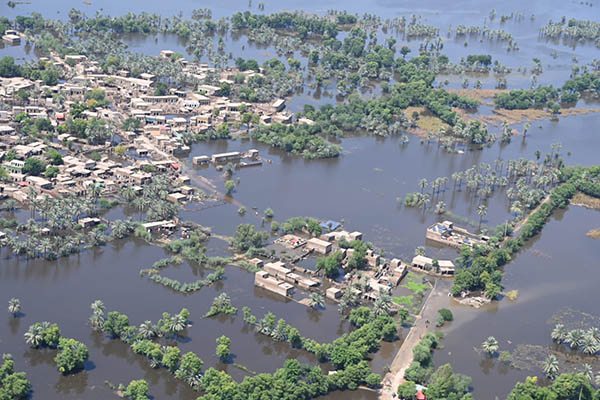
An aerial view of a flood-hit district of Sindh. Twitter
Pakistan needs $16.3 billion to tackle the devastation caused by this year’s floods, but this amount does not factor in the investments needed to strengthen the country’s adaptation to climate change and resilience against future climate shocks, according to a report issued by the Ministry of Planning and Development on Friday.
The Post-Disaster Needs Assessment (PDNA)—prepared jointly by the World Bank, Asian Development Bank (ADB), United Nations Development Program (UNDP), the European Union and the Pakistani government—has stressed that damages and losses caused by floods have reached $30.14 billion, with housing; agriculture; food; livestock; fisheries; transport and communications suffering the brunt of the devastation.
Sindh and Balochistan, it said, account for approximately 50 percent and 15 percent of recovery and reconstruction needs, respectively, adding that the national poverty rate would likely increase by 3.7-4 percent, pushing an additional 8.4-9.1 million people into poverty. Of the 25 poorest districts in the country, it said, 19 were calamity-affected.
Lamenting that Pakistan’s systems and institutions were not adequately equipped for the unprecedented scale of this year’s climate-induced disaster, the report stresses that this year’s floods have further exposed underlying institutional and systemic challenges, including poor urban planning and water resource management, lack of systems for infrastructure maintenance, complex governance, structural inequalities, and limited disaster risk reduction capacity. “Simultaneous multiple shocks, including natural hazards, COVID-19, rising inflation, an energy crisis, and fiscal challenges, continue to compound the impacts,” it said, warning that ongoing political and economic instability were exacerbating the impact of the disaster and undermining the effectiveness of recovery.
Referring to the Government of Pakistan and the U.N.’s joint “flash appeal” for humanitarian aid, the report regretted that only 13.7 percent of the $816 million sought to cover the most urgent needs of 9.5 million people had been funded. “The international community and local and international organizations have provided aid, but accessibility due to standing flood waters, flood effects, and complex topographies remain a major challenge,” it said.
It warned the floods would pose a challenge for Pakistan’s economy for several years, noting that recovery and reconstruction needs are projected to be sizable at 1.6 times the budgeted national development expenditure for the ongoing fiscal year. It said the overall decline in GDP as a direct impact of the floods was projected to be around 2.2 percent of the GDP, adding agriculture sector value was projected to decline the most at 0.9 percent of GDP, with floods causing the most losses to cotton, dates, sugarcane, and rice crops. Flood-related cotton losses, it warned, would similarly, impact the domestic textile industry, hampering exports. Local food processing and slaughtering industries would also be impacted, it said, due to the expected reduction in food harvests and reduced supply of livestock.
The report calls for the International Monetary Fund (IMF) to relax its conditions and for the global community to ensure “climate justice” that would enable Pakistan to invest in rehabilitation and climate adaptation efforts. “Given Pakistan’s limited fiscal resources, significant international support and private investment will be essential for a comprehensive and resilient recovery,” read the report, adding Pakistan’s commitment to accelerate reforms would be critical to generating more domestic and international resources for efficient and effective utilization.
Stressing on stakeholder engagement to inform the scope, design, institutional arrangements, and a monitoring and accountability framework for a comprehensive resilient recovery program, the report said Pakistan aimed to achieve an “inclusive and resilient recovery” through a “Whole of Pakistan” approach, leading to sustainable development for the people and country. This, it said, would entail building back better; a people-centered socioeconomic recovery; and developing systemic resilience against natural hazards and climate change impacts. As a consequence, it said, jobs and livelihoods would be restored; critical assets, services, and infrastructure would be restored; and governance and stakeholder capacity for reconstruction, especially communities, would be strengthened.
Launching the report, Planning Minister Ahsan Iqbal requested the IMF to allow Pakistan to utilize its development funds for disaster recovery, adding it should also ease a condition to spend at least 40 percent of the development budget only in the last quarter of the financial year. Similarly, Climate Change Minister Sherry Rehman said Pakistan had geared up its efforts to make a case for “climate justice” at the COP27 climate change conference in Egypt next month.
